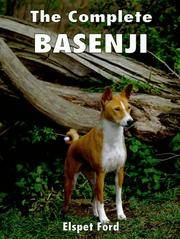This is something else I found really fascinating. sometime back, my wife picked up a book from the library that had been withdrawn from their collection: Ford, Elspet – The Complete Basenji / Elspet Ford ISBN 0-87605-016-X

Chapter 10: Breeding Basenjis had a pretty neat paragraph about color combinations. Hopefully Ms. Ford is ok with me sharing the snippet since I’ve given her credit…
(EDIT) I've since learned that Elspet was English and the sweetest lady you'd ever meet. Another passionate fan and champion of the breed. A generous friend and an easy to travel with partner.
“When Breeding for Colour:
RED TO RED will produce an all red litter, unless both animals carry the recessive tricolour gene, in which case one or more tricolour puppies may result. A tricolour in a litter from a red to red mating may come as a complete surprise to a breeder, especially if, on examination of the pedigrees, the only tricolour ancestors are seven or eight generations back.
RED TO TRICOLOUR will result in all reds unless the red parent carries the tri gene as above. A percentage of the resulting red puppies will carry the tri gene.
BLACK TO RED will give reds, blacks, and again, tricolours may appear if the recessive gene is carried by both parents. Black is a dominant colour and must be present in one parent to ensure black progeny. It is also possible that this mating could result in no black offspring.
BLACK TO TRICLOUR will probably result in all three colours again, depending on the genee carried by the black parent.
BLACK TO BLACK – it is possible that this will again result in all three colours, depending on the color of the parents’ ancestors.
TRICLOLOUR TO TRICOLOUR – the puppies are always tricolour. Recessive blacks can turn up in any litter where both parents carry that particular gene.
BRINDLE is a dominant colour and must be present in one parent, but again, it is possible that a brindle will not be produced in the resulting litter. As the Brindle colour is only present in the United States at the moment, the full potential for the colour has still to be investigated and assessed.”
Again, just fascinating. It made me think of two things right away: how important it is to have a picture in the pedigree, and Stella's (Astarte) use of "With Pips" in her names. I'm guessing that anytime I see "With Pips" in a name, I know that dog is a Tri?
The other thing I didn't know was that Brindles are specific to the the US? I thought for sure I'd seen pictures of Brindles in Africa. I'll have to do some hunting.




 Here's a sample: " There are Concentration and Intensity genetics that are thought to interact phaeomelanin. And as for E - there are 3 locus that are known and can be tested for E, e2 (cream in Australian Cattle dog) and e3 (cream in Siberian Huskies)"
Here's a sample: " There are Concentration and Intensity genetics that are thought to interact phaeomelanin. And as for E - there are 3 locus that are known and can be tested for E, e2 (cream in Australian Cattle dog) and e3 (cream in Siberian Huskies)"